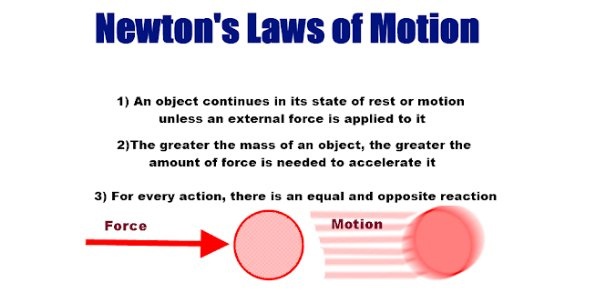Tamilnadu Samacheer kalvi 10th Science Guide Chapter-1

Tamilnadu samacheer kalvi 10th science guide chapter-1-Laws of Motion
PHYSICS
UNIT – 1
Laws of Motion
TEXTBOOK EVALUATION
I. Choose the correct answer :
The inertia of a body depends on
(a) weight of the object
(b) acceleration due to gravity of the planet
(c) mass of the object
(d) Both a & b
Ans. (c) mass of the object
2. Impulse is equals to (PTA-1)
(a) rate of change of momentum
(b) rate of force and time
(c) change of momentum
(d) rate of change of mass
Ans. (c) change of momentum
3. Newton’s III law is applicable
(a) for a body is at rest
(b) for a body in motion
(c) both a & b
(d) only for bodies with equal masses
Ans. (c) both a & b
4. Plotting a graph for momentum on the Y-axis and time on X-axis. Slope of momentum-time graph gives
(a) Impulsive force (b) Acceleration
(c) Force (d) Rate of force
Ans. (c) Force
5. In which of the following sport the turning effect of force used?
(a) swimming (b) tennis
(c) cycling (d) hockey
Ans. (c) cycling
6. The unit of ‘g’ is ms-2. It can be also expressed as
(a) cm s–1 (b) N kg–1
(c) N m2 kg–1 (d) cm2 s–2
Ans. (b) N kg–1
7. One kilogram force equals to
(a) 9.8 dyne (b) 9.8 × 104 N
(c) 98 × 104 dyne (d) 980 dyne
Ans. (c) 98× 104dyne
8. The mass of a body is measured on planet Earth as M kg. When it is taken to a planet of radius half that of the Earth then its value will be ____kg.
(a) 4 M (b) 2 M
(c) M/4 (d) M
Ans. (d) M
9. If the Earth shrinks to 50% of its real radius its mass remaining the same, the weight of a body on the Earth will
(a) decrease by 50% (b) increase by 50%
(c) decrease by 25% (d) increase by 300%
Ans. (d) increase by 300%
10. To project the rockets which of the following principle(s) is /(are) required?
(a) Newton’s third law of motion
(b) Newton’s law of gravitation
(c) law of conservation of linear momentum
(d) both a and c
Ans. (d) both a and c
II. Fill in the blanks :
- To produce a displacement _______ is required. [ANS: force]
- Passengers lean forward when sudden brake is applied in a moving vehicle. This can be explained by _______ [ANS: inertia of motion]
- By convention, the clockwise moments are taken as _______ and the anticlockwise moments are taken as ______ [ANS: negative, positive]
- ___________ is used to change the speed of car. [ANS: Gear or Torque]
- A man of mass 100 kg has a weight of___________ at the surface of the Earth. [ANS: 980 N]
III. State whether the following statements are true or false. Correct the statement if it is false:
- The linear momentum of a system of particles is always conserved.
False.
Correct Statement : In the absence of external force, the linear momentum of a system of particle is always conserved.
2. Apparent weight of a person is always equal to his actual weight
False.
Correct Statement : Apparent weight of a person is not equal to his actual weight.
3. Weight of a body is greater at the equator and less at the polar region.
False.
Correct Statement : Weight of the body is less at equator, more at polar region.
4. Turning a nut with a spanner having a short handle is so easy than one with a long handle.
False.
Correct Statement : Turning a nut with a spanner having a long handle is so easy than one with a short handle.
5. There is no gravity in the orbiting space station around the Earth. So the astronauts feel weightlessness.
False.
Correct Statement : When space station and astronauts have equal acceleration, they are under free fall condition, so both astronaut and space station are in the state of weightlessness.
- Match the following :
| Column I | Column II | ||
| (a) | Newton’s I law | – | propulsion of a rocket |
| (b) | Newton’s II law | – | Stable equilibrium of a body |
| (c) | Newton’s III law | – | Law of force |
| (d) | Law of conservation of linear momentum | – | Flying nature of bird |
Ans.
| Column I | Column II | ||
| (a) | Newton’s law | – | stable equilibrium of a body |
| (b) | Newton’s II law | – | Law of force |
| (c) | Newton’s III law | – | Flying nature of bird |
| (d) | Law of conservation
of linear momentum |
– | propulsion of a rocket |
- Assertion and Reason :
Mark the correct choice as
(a) If both the assertion and the reason are true and the reason is the correct explanation of assertion.
(b) If both the assertion and the reason are true, but the reason is not the correct explanation of the assertion.
(c) Assertion is true, but the reason is false.
(d) Assertion is false, but the reason is true.
2. Assertion: The sum of the clockwise moments is equal to the sum of the anticlockwise moments.
Reason: The principle of conservation of momentum is valid if the external force on the system is zero. Ans. (b) Both the assertion and the reason are true, but the reason is not the correct explanation of the assertion.
3. Assertion: The value of ‘g’ decreases as height and depth increases from the surface of the Earth.
Reason: ‘g’ depends on the mass of the object and the Earth. Ans. (c) Assertion is true, but the reason is false
Hint:
‘g’ depends on the geometric radius of the Earth.
- Answer briefly :
Define inertia. Give its classification.
The inherent property of the body to resist any change in its state of rest or the state of uniform motion unless it is influenced upon by an external unbalanced force is known as “inertia”.
Classification:
Inertia of rest
Inertia of motion
Inertial of direction
Classify the types of force based on their application.
(i)
Like parallel forces: Two or more forces of equal or unequal magnitude acting along the same direction, parallel to each other are called like parallel forces.
(ii) Unlike parallel forces: If two or more equal forces or unequal forces act along opposite directions parallel to each other, then they are called unlike parallel forces.
If a 5 N and a 15 N forces are acting opposite to one another. Find the resultant force and the direction of action of the resultant force
F1 = 5 N;
F2 = 15 N
R = F2 – F1 (if F2 > F1)
= 15 – 5 = 10
Resultant force = 10 N
Resultant force of 10 N is acting in the direction of F2. (i.e.) greater force.
Differentiate mass and weight.
| Mass | Weight | |
| (i) | It is the quantity of matter contained in the body | It is the gravitational force exerted on a body due to the gravity. |
| (ii) | It is a scalar quantity | It is a vector quantity |
| (iii) | SI unit is kg (kilogram) | SI unit is N (newton) |
| (iv) | Mass of a body remains the same at any point on the Earth | Weight of a body varies from one place to another place on the Earth |
| (v) | Measured using a physical balance | Measured using a spring balance |
Define moment of a couple.
Rotating effect of a couple is known as moment of a couple.
Moment of a couple = Force × perpendicular distance between the line of action of forces, M = F × S
State the principle of moments. [Qy-2019]
When a number of like or unlike parallel forces act on a rigid body and the body is in equilibrium then the algebraic sum of moments in clockwise direction is equals to the algebraic sum of moments in anticlockwise direction.
Moment in clockwise direction
= Moment in anticlockwise direction,
F1 × d1 = F2 × d2
State Newton’s second law. [GMQP-2019]
The force acting on a body is directly proportional to the rate of change of linear momentum of the body and the change in momentum takes place in the direction of force.
F = m × a
Force = mass × acceleration
Why a spanner with a long handle is preferred to tighten screws in heavy vehicles?
(i) The turning effect of a body depends upon the distance of the line of action of the applied force from the axis of rotation.
(ii) Larger the perpendicular distance, lesser is the force required to turn the body. So spanner with long handle is preferred.
While catching a cricket ball the fielder lowers his hands backwards. Why?
When the fielder pulls back his hands he experiences a smaller force for a longer interval of time leading to less damage to his hands.
How does an astronaut float in a space shuttle?
Astronauts are not floating but falling freely around the Earth due to their huge oribital velocity. Since spacestation and astronauts have equal acceleration, they are under free fall condition. (R = 0 refer case 4 in Table 1.2). Hence, both the astronauts and the spacestation are in the state of weightlessness.




